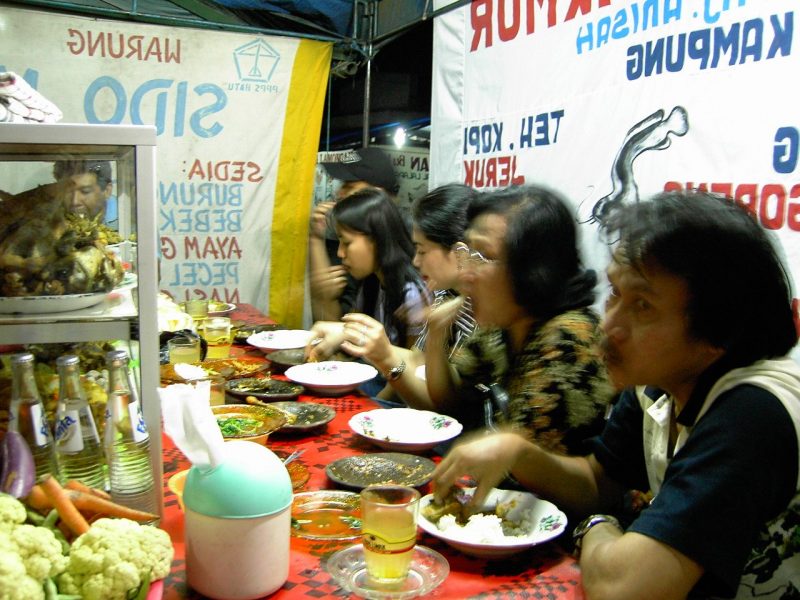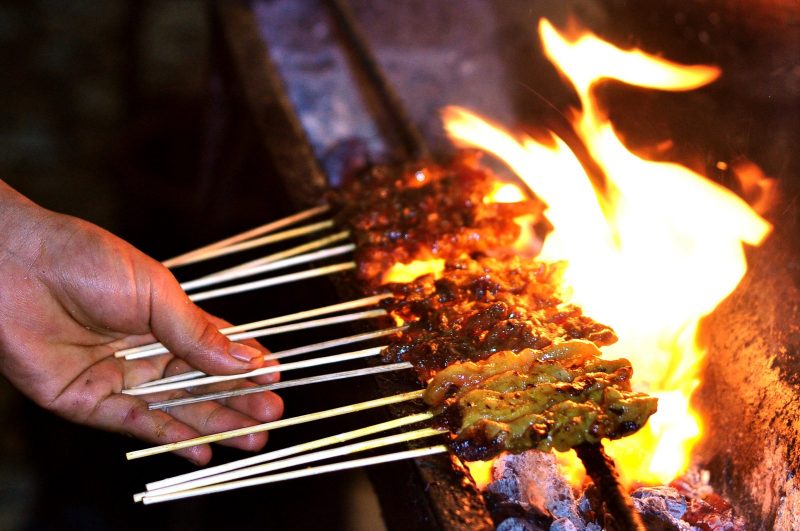Indonesian culture and its cuisine
Indonesia’s local restaurants and roadside food stalls, known as warung in Bahasa Indonesia, can be found along almost every street in the country and offer the culinarily inquisitive Western immigrant plenty of new and novel pleasures to sink their dentures into. Before we proceed though, a brief word of advice to greenhorns and newcomers to the country.
General standards of hygiene and cleanliness will usually be several chilli-sauce stained rungs lower in Indonesia than they are in Western countries, so it’s best to tread a little cautiously at first. Indeed, during my first year here, I spent more time in the bathroom than Elvis did in his final days, although I guess for opposite reasons.
After that though, my digestive system seemed to grow an asbestos lining that allowed me to sample the delights of my local warung on an almost daily basis. Indeed, who needs refrigeration when you have a dainty little frilly net curtain to keep the microbes at bay. In fact, it never ceases to amaze me how such tasty Indonesian delights and fresh dishes managed to emerge from kitchens that look like Guatemalan prison cells after a heavy riot.
And to be sure, it’s actually possible to eat pretty healthily at a decent warung. Just avoid going too heavy on the fried stuff and select wisely from a dozen or so brightly coloured plastic trays or plates of delicious vegetable and meat dishes and you’ll do just fine. Rice, vegetables, grilled fish or chicken, a hard-boiled egg, a perkedel (potato cake) and a spoonful of sambal (chilli sauce) should set you up for the rest of the day. Chase it all down with an es jeruk (iced, freshly squeezed orange juice), which will only occasionally taste slightly of washing-up liquid, and you’ll never look back.
So, let’s break down some of the most popular warung foods.
Bakso
I’ll start with the worst first. These gelignite and plasticine aberrations (or “meatballs”) are, for reasons that still elude me, loved with a fervent passion by locals who have plenty of far superior and undoubtedly healthier snack foods to choose from. Go figure. I’d certainly advise caution where these petrochemical pipeline tailings are concerned. Instant noodles rate slightly higher on the Indonesian snacking scale, especially with a nice egg thrown into the mix, although you may ultimately conclude that there is a greater amount of nutritional content in the plastic wrappers that they come in than the actual noodles themselves.
Satay
Undoubtedly Indonesia’s most iconic dish, sate, as it’s spelt in Bahasa Indonesia, can be found being hawked around Indonesia’s streets at all hours of the day and night. Street vendors usually sell their satay along with lontong (compressed rice cakes) wrapped in banana leaf. Peanut sauce, sweet soy sauce and chilli work wonderfully together with these mini chicken skewers. Be aware though that when purchased off the street, satay sticks often feature very small lumps of chicken which are stretched still further by their hawkers who alternate said micro-chunks with lumps of pure fat and gristle. Satay ordered at a classier Indonesian restaurant will give you more substantial chunks of chicken (or indeed mutton), however, they often don’t quite capture the absolutely delicious blend of sauces that you get out on the street.
Nasi Rames
Javanese warungs will typically present you with around 20 or so trays of generally cold delights for hungry lunch lovers to select from in order to augment a plate of steaming white rice. Dine-in or opt for a brown paper bungkus to take back to your office or home. Personal favourites include tuna and tongkol (mackerel tuna) in mild chilli sauce, grilled chicken, labu (shredded green pumpkin), pare (bitter gourd) and, of course, the ubiquitous tempeh. A nasi rames makes for an excellent lunch, although obviously, some warung are superior to others. So, investigate your local neighbourhood and try to winkle out the best ones, which is usually quite easy, as they will usually be filled with be-helmeted Grab drivers.
Nasi Padang
Perhaps Indonesia’s most iconic cuisine, Masakan Padang, has spread across the whole country from its origin among the Minangkabau people of West Sumatra. Perhaps not quite as healthy as a judiciously selected nasi rames of grilled fish and vegetables owing to the ubiquitous presence of coconut cream in its many devilishly curried delights (which bespeak Indian and Middle Eastern influences), Padangnese food can prove powerfully addictive nonetheless. In fact, there are over 20,000 Padang restaurants in Jakarta alone and you may find yourself regularly chowing down on the stuff like so many others across this fair nation. The most iconic Padang dishes are probably nangka (stewed jackfruit) – a delicious vegetable substitute – and, of course, beef rendang, a rich, coconutty beef stew that is slow-cooked and simply packed with flavour.
At fancier Padang establishments, all of the available dishes are piled onto the customer’s table and the diner is only charged for the dishes that they eat from. Splash on plenty of green sambal (which is milder than other types of Indonesian chilli sauce) and enjoy. Another word of caution though, you may wish to avoid some of the more offal-based dishes on offer (unless you’re a fan of chewing on lungs or cows’ brains).
Manadonese Food
Somewhat rarer than the two warung staples outlined above (unless you are actually in North Sulawesi of course), Manadonese food differs considerably from other Indonesian cuisines and really has to be tried when you get the opportunity. There is a growing awareness of this marvellous cuisine across the country and Manadonese restaurants are currently springing up all over Indonesia’s major cities. Being from a largely non-Islamic part of the country, pork features regularly, which may pique your interest, as do bats and dogs, which probably won’t. However, it’s the seafood that generally gets the taste buds a zinging the most and the Minahasan people really know their way around a nice fresh fish. Smoked cakalang (skipjack tuna) and fish soups such as woku-woku are particularly toothsome. Things can get very spicy, however, so tread carefully.
And that just about rounds things up for this week. Take it easy out there, always have some charcoal tablets and Imodium at home in case of emergencies, but above all, eat until replete. Over and out.




